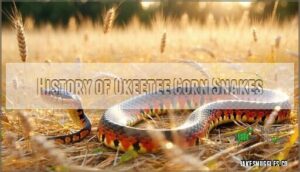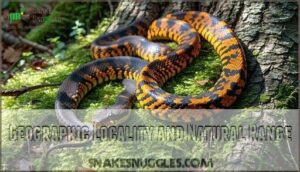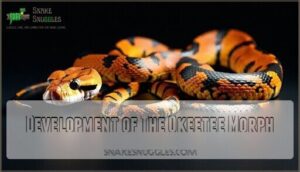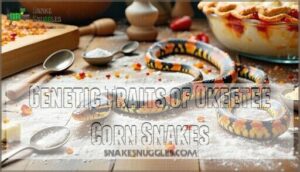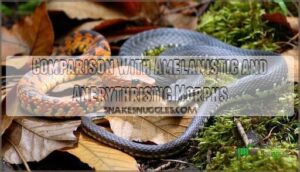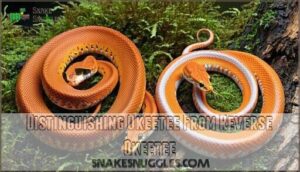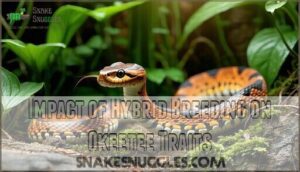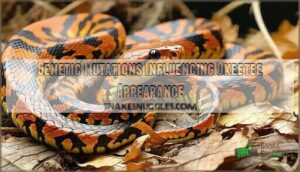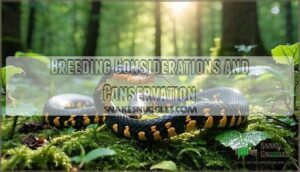This site is supported by our readers. We may earn a commission, at no cost to you, if you purchase through links.

The region they come from in South Carolina gave them their dramatic looks and adaptable personalities. Careful breeders handpicked each trait across generations like piecing together a jigsaw puzzle. But stray too far from the original gene pool, and you might lose those signature patterns.
Want to know how these snakes keep their good looks (and what can go wrong)? Stick around.
Table Of Contents
Key Takeaways
- You’ll see Okeetee corn snakes get their dramatic colors and crisp patterns from selective breeding and polygenic genetics, not just a single gene. – Bold looks come from generations of carefully paired snakes—stray too far from the original lines, and you might lose the Okeetee’s trademark patterns. – Hybridizing with other morphs or losing genetic diversity can weaken those classic features, making responsible breeding and conservation essential. – Okeetee genetics determine appearance, not temperament, so expect the same friendly corn snake personality under those striking looks.
Okeetee Corn Snake Morph Origins
You’ll find the Okeetee corn snake’s origins in South Carolina, where breeders selected for bold red color and crisp black borders.
These snakes didn’t just wake up fancy—they’re the result of generations of careful pairing and a bit of old-fashioned human curiosity.
History of Okeetee Corn Snakes
Out in the Hunt Club’s open fields, early breeders set out to make something truly unique. Here’s why Okeetee history still stands out:
- Initial Selection shaped bold color origins. – Extreme Okeetee phase wowed collectors. – Lineage purity stayed golden. – Reverse Okeetee Corn Snake turned heads. – Corn snake localities set the stage for legends.
Geographic Locality and Natural Range
When you think about Corn snake localities, Okeetee snakes truly stand out. These wild populations hail from South Carolina’s Okeetee region, a hotbed of habitat diversity. Geographic features shape regional variations and adaptability. Their conservation status is stable, though range expansion is slow. It’s like these snakes prefer sticking to their home turf, resisting wanderlust.
————–:
——————–:
———————:
Development of The Okeetee Morph
After getting to know the Okeetee’s native hotspots, you’ll love seeing how their look evolved. Here’s how these bold Corn snake morphs became legends through Selective Breeding and Genetic Selection:
- Color Intensification
- Trait Fixation in captive pairs
- Focus on distinct Lineage Development
- Abbott’s Okeetee lines emerged
- New Corn snake genetics shaped the morph
Genetic Traits of Okeetee Corn Snakes
You’ll notice Okeetee corn snakes don’t get their bold colors and patterns from just one gene—they’re the result of careful selective breeding over many generations.
If you picture trying to bake the perfect pie for years, you’re on the right track to understanding how these traits stack up.
Polygenic Inheritance Patterns
Every Okeetee corn snake is a living tapestry of genetic variation. Instead of one gene calling the shots, polygenic effects create dramatic trait expression—thick borders, bold color—a bit like painting with a handful of brushes at once.
Corn snake genetics is a juggling act, where gene interaction and inheritance models lead to endless, fascinating patterns right in your hands. The study of lysosome related organelles helps us understand the genetic basis of these patterns.
Key Physical Characteristics
Now that you’ve got polygenic inheritance in mind, picture the Okeetee Corn Snake up close. You’ll notice bold stripes, jaw-dropping Snake Markings, and scale patterns that could win a beauty contest.
Their rich eye colors and body texture make them stand out from other morphs. Genetics really knows how to paint a masterpiece here!
Selective Breeding for Color and Pattern
Selective breeding shapes the Okeetee’s bold colors and crisp patterns—you’re basically playing genetic chess with Corn Snake genetics. Want brighter reds or thicker saddle borders? Use smart breeding strategies guided by Color Genetics and Pattern Inheritance.
- Watch for unexpected color variations. – Track family lines closely. – Mix Morph Development with careful pairings. – Embrace genetic variation; every hatchling’s a surprise.
Okeetee Versus Other Corn Snake Morphs
When you compare Okeetee corn snakes to other morphs, you’ll spot bold borders and brighter reds that set them apart thanks to selective breeding.
It’s a bit like picking out a celebrity in a crowd—genetics make the features pop, and you don’t need night-vision goggles to see the difference.
Comparison With Amelanistic and Anerythristic Morphs
Looking at Color Genetics in corn snakes shows that Okeetee morphs stand out with their bright orange and bold patterns, thanks to polygenic Pattern Inheritance.
In a Morph Comparison, Amelanistic corn snakes trade their blacks for pops of red and orange, while Anerythristic morphs keep things grayscale.
These genes shape Snake Breeding and boost Genetic Variance for Corn Snake Genetics.
Distinguishing Okeetee From Reverse Okeetee
When you’re staring at an Okeetee, think bold black outlines with fiery reds—classic Okeetee Identification. Reverse Okeetee flips the script with thick white borders and wild, bright orange thanks to Amel genetics.
Genetic tests just won’t give you the answers here, so identifying these morphs really comes down to an artful eye.
And if you add Tessera genes into the mix, things can get even trickier in the Corn Snake world.
Impact of Hybrid Breeding on Okeetee Traits
Every time you cross Okeetee with other morphs, hybrid vigor pops up, but so does genetic drift. That means trait expression—like those bold saddle borders—may blur with each generation.
If you want Okeetee’s look to stick around, you’ll need careful breeding. Otherwise, morph stability dips, and breeding outcomes will mix in surprises like Tessera or other genetics.
Genetic Mutations Influencing Okeetee Appearance
You’ll spot some wild changes in Okeetee corn snakes thanks to genetic mutations like Amel, Hypo, and Tessera.
These genes mix things up in surprising ways, so it’s a bit like Mother Nature experimenting with a new color palette for your snake.
Role of Amel, Hypo, and Tessera Genes
To really get what makes corn snake morphs unique, it helps to look at how their genes and mutations shape things like color and pattern.
Three key players in Okeetee genetics are:
- Amel (Amelanistic): wipes out black pigment.
- Hypo (Hypomelanistic): dials down black.
- Tessera: adds crisp striping.
Genetic Variability keeps things interesting. Understanding the Hypomelanistic gene effects is essential for breeders to predict and achieve desired color patterns.
Effects of Dominant, Recessive, and Polygenic Genes
Getting into corn snake genetics can feel a bit like figuring out who’s related at a big family picnic. Dominant genes make themselves obvious in the crowd, while recessive ones keep a low profile until the right moment.
Polygenic traits—think vibrant color or saddle borders—are like a team huddle, working together.
Digging into genetic expression, how genes interact, mutation rates, and heritability gives you a clearer picture of how each genotype ends up shaping a snake’s traits.
Common Genetic Combinations in Okeetee Lines
Peeking into Okeetee lines, you’ll bump into wild genetic variance—think mashups of Abbotts Okeetee Corn Snake, Reverse Okeetee (RO), Extreme Reverse Okeetee (ERO), and Tessera mutation inheritance.
These combos spice up color patterns and morph expression. Understanding inheritance types sharpens your breed predictions, giving you a leg up when experimenting with those eye-catching Okeetee hybrids.
Breeding Considerations and Conservation
When you breed Okeetee corn snakes, you’ve got to balance preserving their bold patterns with maintaining healthy, diverse genetics.
Responsible breeding helps guarantee you don’t end up with a snake family reunion that’s just too closely related.
Challenges in Maintaining Okeetee Traits
It’s easy to feel like you’re chasing your tail maintaining classic Okeetee traits. You’ll run into Genetic Drift, surprise Polygenic Effects, and the unpredictable rollercoaster of Color Stability. Breeding Challenges pop up everywhere—even producing Reverse Okeetee RO or Extreme Reverse Okeetee ERO isn’t foolproof. Genetics can humble the best laid plans!
- Genetic Drift leads to trait loss. – Polygenic Effects complicate patterns. – Breeding Challenges limit predictability. – Color Stability often varies generation to generation. – Reverse Okeetee RO and ERO demand careful genetics work.
Influence of Captive Breeding Practices
Look at how captive breeding shapes Okeetee genetics. You’re juggling genetics, inheritance, and ethical choices with every clutch. Careful pairing keeps those classic corn snake patterns crisp, but hybridization effects and rushed crosses can muddy the gene pool.
Take a peek at the table below for quick insights on breeding impacts:
| Factor | Influence |
|---|---|
| Captive Breeding | Controls traits |
| Genetic Diversity | Prevents inbreeding |
| Breeding Ethics | Sustains lines |
| Hybridization Effects | Alters patterns |
| Pattern Genetics | Enhances variety |
Conservation of Locality and Genetic Diversity
Usually, saving Okeetee corn snakes means more than keeping their genes in a pickle jar. Wild Okeetee Decline, Habitat Loss Impact, and Genetic Bottlenecks are real roadblocks. Want to aid? Try these:
- Champion ex-situ conservation
- Keep studbooks for locality
- Test for key mutations
- Choose responsible breeding partners
- Preserve wild genetic traits
Frequently Asked Questions (FAQs)
Can Okeetee corn snakes be het for other traits?
When you open the genetic treasure chest of Okeetee corn snakes, you’ll find surprises—yes, they can be “het” for traits like Amel, Hypo, or others, passing hidden genetics to their babies over generations.
How do Okeetee genetics impact temperament?
Okeetee genetics shape color, not personality; you won’t find a grumpy snake from bold stripes alone.
With handling, an Okeetee’s temperament mirrors other corn snakes—generally mellow, curious, and easy to work with.
Are there visual markers of inbreeding in Okeetee lines?
You might spot inbreeding by faded colors, smaller size, or odd scales, like a snake that missed a memo. If you see these, it’s nature waving a little red flag—time to mix things up!
What is the average clutch size for Okeetee morphs?
Think more farmer’s basket than empty fridge—average clutch size ranges from 10 to 30 eggs.
You get variation from snake to snake, but you can bet on a full house come breeding season!
Conclusion
Think of Okeetee corn snake genetics like tuning a radio—each trait needs just the right frequency. If you want those classic bold looks, you’ve got to mind the genes and avoid crossing wires with other morphs.
Understanding Okeetee corn snake genetic facts gives you the power to keep their patterns vivid and traits strong. It’s all about careful choices, patience, and a little bit of science on your side to keep these beauties shining bright.
- https://omgsnakes.com/post/744954353841045504/what-is-okeetee-biologically-how-does-it-work-and
- https://a-z-animals.com/blog/corn-snake-morphs-the-complete-list/
- https://dgbexotics.com/corn-snake-genetics
- https://community.morphmarket.com/t/help-with-understanding-okeetee-genetics/38892
- https://www.allaboutcornsnakes.com/corn_snakes.html

